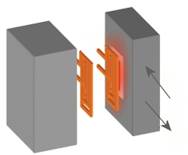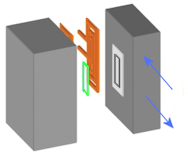High frequency electrical current can be generated at the surface of the mold by the skin effect, using a high frequency electromagnetic field.
Approaches to implementing the skin effect include induction heating and proximity heating. Electrical induction heating allows for lower cycle times due to the precise control and positioning of the heat flux density and rate within the mold. Infrared radiation can also be used to heat the cavity surface, but all three of these approaches involve high initial investments in equipment.
Induction heating
Induction heating is a very complex technology and is very dependent upon the correct choice of mold materials. The strategic placement of highly magnetic inserts on the part where heating is desired is very important, as well the placement of metal inserts with poor magnetic properties in the mold to enhance the magnetic field near the part. The placement and exact geometry of the induction coils are also very important and need to be modeled in exact detail.
Induction heating is entirely dependent upon the metallurgical properties of the metals on which it is being applied. Metals have electromagnetic properties in the same way as they have thermal and structural properties. The most important electromagnetic properties needed for simulating induction heating are the metal's electrical conductivity and magnetic permeability.
Induction heating takes just a few seconds to raise the mold temperature. The cooling process is also very fast because induction heating only heats the steel surface to a depth of around 100 µm, thus heat is lost relatively quickly.
(A) (B)
(B) (C)
(C)
(A) Heating on, water cooling off, (B) heating off, mold closes, injection occurs, cooling on, (C) mold opens, part ejected.
Induction Heating